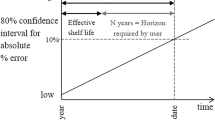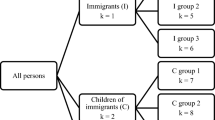Abstract
I develop probabilistic interpretations for the United Nations’ 10-year population forecasts by comparing 1995 projections for 212 countries to the population sizes reported for 2005. Errors in the estimation of the intrinsic rate of increase, presumably caused by erroneous assumptions about birth, death and/or immigration rates, appear to be more consequential than errors based on inaccurate estimation of the starting, or ‘jump-off’, population size. For only about 20% of the countries did the ‘actual’ 2005 population size fall between the United Nations’ low- and high-variant projections. I propose prediction intervals for country-specific population sizes 10 years in the future of the form \([ N_i^{\prime} (t+10) / k , \, k \cdot N_i^{\prime} (t+10) ],\) where N i ′(t + 10) is the medium-variant prediction for year t + 10 made in year t, and k is a number that varies with starting population size. Based on the 1995–2005 United Nations’ data, values of k giving 95% coverage range from 1.11 for countries with a population on the order of 109, to 1.45 for countries with a population of 105.







Similar content being viewed by others
References
Alho, J. M. (1997). Scenarios, uncertainty and conditional forecasts of the world population. Journal of the Royal Statistical Society. Series A (Statistics in Society), 160, 71–85.
Alho, J. M., & Spencer, B. D. (2005). Statistical demography and forecasting. New York: Springer.
Booth, H. (2006). Demographic forecasting 1980 to 2005 in review. International Journal of Forecasting, 22, 547–581.
Hyndman, R. J., & Booth, H. (2008). Stochastic population forecasts using functional data models for mortality fertility and migration. International Journal of Forecasting, 24, 323–342.
Keilman, N. (2001). Data quality and accuracy of United Nations population projections, 1950–95. Population Studies, 55, 149–164.
Keilman, N., Pham, D. Q., & Hetland, A. (2002). Why population forecasts should be probabilistic illustrated by the case of Norway. Demographic Research, 6, 409–454.
Lee, R. D., & Tuljapurkar, S. (1994). Stochastic population forecasts for the United States beyond high, medium, and low. Journal of the American Statistical Association, 89, 1175–1189.
Li, Q., Reuser, M., Kraus, C., & Alho, J. (2009). Ageing of a giant: A stochastic population forecast for China 2006–2060. Journal of Population Research, 26, 21–50.
Lutz, W., Sanderson, W. C., & Scherbov, S. (2004). The end of world population growth. In W. Lutz, W. C. Sanderson, & S. Scherbov (Eds.), The end of world population growth in the 21st century: New challenges for human capital formation & sustainable development (pp. 17–83). London: Earthscan.
National Research Council (2000). Beyond six billion: Forecasting the world’s population. Washington, DC: National Academy Press.
O’Neill, B. C., Balk, D., Brickman, M., & Ezra, M. (2001). A guide to global population projections. Demographic Research, 4, 203–288.
O’Neill, B. C., & W. Sanderson. (2008). Population, uncertainty, and learning in climate change decision analysis. Climatic Change, 89, 87–123.
Rayer, S. (2008). Population forecast errors a primer for planners. Journal of Planning Education and Research, 27, 417–430
Sanderson, W. C., Scherbov, S., Lutz, W., & O’Neill, B.C. (2004). Applications of probabilistic population forecasting. In W. Lutz, W. C. Sanderson, & S. Scherbov (Eds.), The end of world population growth in the 21st century: New challenges for human capital formation & sustainable development (pp. 85–119). London: Earthscan.
Stoto, M. (1983). The accuracy of population projections. Journal of the American Statistical Association, 78, 13–20.
United Nations. (1999). World population prospects: The 1998 revision. United Nations, New York.
United Nations. (2009). World population prospects: The 2008 revision. http://www.un.org/popin/functional/population.htm.
Wilson, T. (2007). The forecast accuracy of Australian Bureau of Statistics national population projections. Journal of Population Research, 24, 91–117.
Acknowledgments
I am grateful to two anonymous reviewers for many constructive suggestions for improving the manuscript.
Author information
Authors and Affiliations
Corresponding author
Rights and permissions
About this article
Cite this article
Murtaugh, P.A. A probabilistic interpretation of the United Nations’ 1995–2005 population projections. J Pop Research 27, 63–73 (2010). https://doi.org/10.1007/s12546-010-9034-1
Published:
Issue Date:
DOI: https://doi.org/10.1007/s12546-010-9034-1




